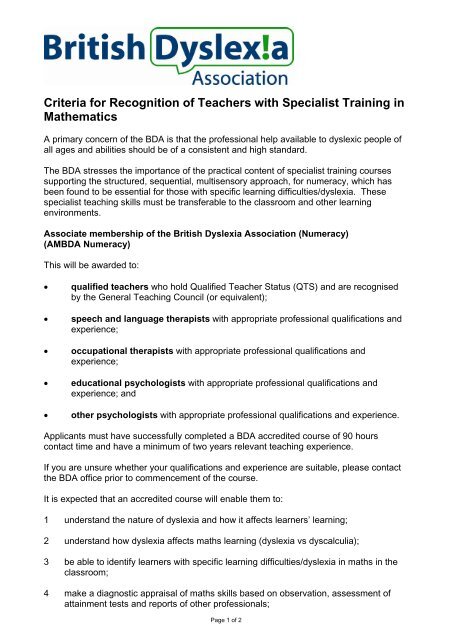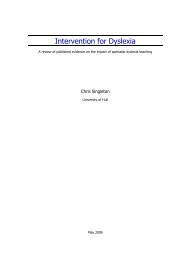Criteria for Recognition of Teachers with Specialist Training in ...
Criteria for Recognition of Teachers with Specialist Training in ...
Criteria for Recognition of Teachers with Specialist Training in ...
- No tags were found...
Create successful ePaper yourself
Turn your PDF publications into a flip-book with our unique Google optimized e-Paper software.
<strong>Criteria</strong> <strong>for</strong> <strong>Recognition</strong> <strong>of</strong> <strong>Teachers</strong> <strong>with</strong> <strong>Specialist</strong> <strong>Tra<strong>in</strong><strong>in</strong>g</strong> <strong>in</strong>MathematicsA primary concern <strong>of</strong> the BDA is that the pr<strong>of</strong>essional help available to dyslexic people <strong>of</strong>all ages and abilities should be <strong>of</strong> a consistent and high standard.The BDA stresses the importance <strong>of</strong> the practical content <strong>of</strong> specialist tra<strong>in</strong><strong>in</strong>g coursessupport<strong>in</strong>g the structured, sequential, multisensory approach, <strong>for</strong> numeracy, which hasbeen found to be essential <strong>for</strong> those <strong>with</strong> specific learn<strong>in</strong>g difficulties/dyslexia. Thesespecialist teach<strong>in</strong>g skills must be transferable to the classroom and other learn<strong>in</strong>genvironments.Associate membership <strong>of</strong> the British Dyslexia Association (Numeracy)(AMBDA Numeracy)This will be awarded to:• qualified teachers who hold Qualified Teacher Status (QTS) and are recognisedby the General Teach<strong>in</strong>g Council (or equivalent);• speech and language therapists <strong>with</strong> appropriate pr<strong>of</strong>essional qualifications andexperience;• occupational therapists <strong>with</strong> appropriate pr<strong>of</strong>essional qualifications andexperience;• educational psychologists <strong>with</strong> appropriate pr<strong>of</strong>essional qualifications andexperience; and• other psychologists <strong>with</strong> appropriate pr<strong>of</strong>essional qualifications and experience.Applicants must have successfully completed a BDA accredited course <strong>of</strong> 90 hourscontact time and have a m<strong>in</strong>imum <strong>of</strong> two years relevant teach<strong>in</strong>g experience.If you are unsure whether your qualifications and experience are suitable, please contactthe BDA <strong>of</strong>fice prior to commencement <strong>of</strong> the course.It is expected that an accredited course will enable them to:1 understand the nature <strong>of</strong> dyslexia and how it affects learners’ learn<strong>in</strong>g;2 understand how dyslexia affects maths learn<strong>in</strong>g (dyslexia vs dyscalculia);3 be able to identify learners <strong>with</strong> specific learn<strong>in</strong>g difficulties/dyslexia <strong>in</strong> maths <strong>in</strong> theclassroom;4 make a diagnostic appraisal <strong>of</strong> maths skills based on observation, assessment <strong>of</strong>atta<strong>in</strong>ment tests and reports <strong>of</strong> other pr<strong>of</strong>essionals;Page 1 <strong>of</strong> 2
5 demonstrate an understand<strong>in</strong>g <strong>of</strong> structured, sequential, multisensory teach<strong>in</strong>g<strong>in</strong>clud<strong>in</strong>g evaluation <strong>of</strong> teach<strong>in</strong>g materials;6 deliver and evaluate the programme;7 review classroom organisation to facilitate <strong>in</strong>dividual learn<strong>in</strong>g <strong>with</strong><strong>in</strong> the NationalCurriculum and National Numeracy Strategy, or their equivalents;8 communicate effectively <strong>with</strong> parents, teachers and other pr<strong>of</strong>essionals by verbal andwritten reports on a learner’s needs and achievements <strong>in</strong> relation to maths and makerecommendations <strong>for</strong> remediation;9 accurately observe and assess the cognitive abilities and learn<strong>in</strong>g styles <strong>of</strong> <strong>in</strong>dividuallearners and the difficulties faced by learners who fail to become competent <strong>in</strong>numeracy;10 critically appraise a range <strong>of</strong> numeracy teach<strong>in</strong>g programmes;11 show familiarity <strong>with</strong> appropriate research and an understand<strong>in</strong>g <strong>of</strong> the prerequisitesto learn<strong>in</strong>g maths;12 design and evaluate appropriate programmes, <strong>in</strong>clud<strong>in</strong>g those which could be used<strong>in</strong> the National Numeracy Strategy framework, <strong>in</strong> relation to the assessed needs <strong>of</strong> arange <strong>of</strong> students; and13 be conversant <strong>with</strong> the potential <strong>of</strong>fered by ICT <strong>in</strong> the teach<strong>in</strong>g <strong>of</strong> specific learn<strong>in</strong>gdifficulties/dyslexia, <strong>in</strong> particular <strong>in</strong> relation to maths, and <strong>of</strong> the range <strong>of</strong> relevanttechnical aids to teach<strong>in</strong>g.There is an expectation that such a course will provide a m<strong>in</strong>imum <strong>of</strong> 90 hours <strong>of</strong> lecturesand sem<strong>in</strong>ars, plus private study time. At least three hours <strong>of</strong> teach<strong>in</strong>g and one hour <strong>of</strong>diagnostic assessment must be observed and assessed by the course tutor, but use <strong>of</strong>video/audiotaped record<strong>in</strong>g <strong>of</strong> lessons is permissible.The BDA considers these criteria to be essential <strong>in</strong> establish<strong>in</strong>g Associate Membership <strong>of</strong>the BDA (Numeracy). However, it does not presume to <strong>in</strong>sist upon specific aspects <strong>of</strong>course structure or the academic aspects <strong>of</strong> assessment procedures, nor does it seek toact as a secondary exam<strong>in</strong><strong>in</strong>g body <strong>in</strong> these respects. Courses or <strong>in</strong>dividuals whosetra<strong>in</strong><strong>in</strong>g procedures differ from those outl<strong>in</strong>ed above, but who otherwise meet the setcriteria, are <strong>in</strong>vited to seek accreditation.Any candidate wish<strong>in</strong>g to seek BDA accreditation who has not fulfilled the practicalcomponents specified above will be required to attend and fulfil this <strong>with</strong><strong>in</strong> the framework<strong>of</strong> a BDA accredited course.Please note that while AMBDA is an accepted qualification <strong>for</strong> the provision <strong>of</strong>support evidence on behalf <strong>of</strong> exam<strong>in</strong>ation candidates <strong>with</strong> learn<strong>in</strong>g difficulties,AMBDA Numeracy is not recognised <strong>in</strong> this way.A suggested programme to accompany these criteria is also available from the BDAEducation Department. Tel: 01344 381 560, Fax: 0845 251 9005Email: accreditation@bdadyslexia.org.uk.© BDA. February 2003Copies may be made provided the source and date are quoted and the content is unchanged.Registered Charity No. 289243. Company Ltd. No. 1830587Page 2 <strong>of</strong> 2









